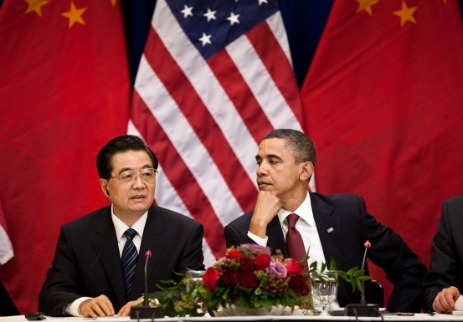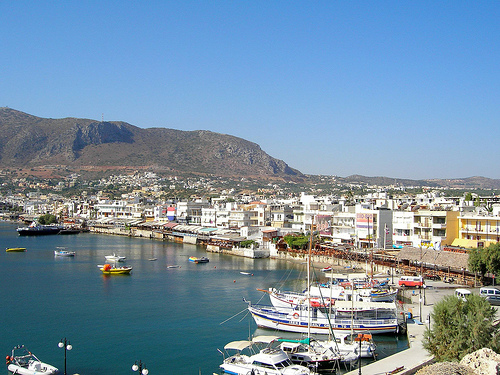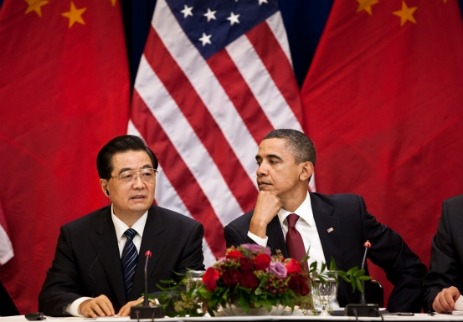 Proof that he is, in fact, that into Hu.Photo: The White HouseThe truly astonishing amount of material that came out after a recent visit by China’s President Hu Jintao is a measure of how pivotal energy and climate change are between the U.S. and China. This includes a piece on the importance of energy cooperation between the two nations by U.S. Secretary of Energy Steven Chu himself.
Proof that he is, in fact, that into Hu.Photo: The White HouseThe truly astonishing amount of material that came out after a recent visit by China’s President Hu Jintao is a measure of how pivotal energy and climate change are between the U.S. and China. This includes a piece on the importance of energy cooperation between the two nations by U.S. Secretary of Energy Steven Chu himself.
Scientific American’s Dave Biello describes the relationship between the U.S. and China as the kind of detente that exists between “frenemies,” but one of the most comprehensive assessments of the current state of affairs was articulated by Daniel Firger of the Columbia Center for Climate Change Law. He says the year to come in China and U.S. energy news will revolve around three things:
- The U.S. complaint to the World Trade Organization about China’s green energy subsidies, which seems hypocritical in light of our failure to make similar complaints about E.U. subsidies (not to mention our own domestic subsidies), could be a sticking point in U.S.-China relations;
- China’s burgeoning scientific engine, which could drive renewables to become economically competitive with fossil fuels in the U.S.;
- And lastly, the economies of scale achieved by China’s enormous domestic market, which could make renewables a reality for the billions of people whose only choice is between dirty energy and no energy at all.
GOOD magazine made a similar argument in 2009, when it argued that Chinese innovation would revolutionize solar for the entire world.
China, U.K.: As serious as a heart attack about energy efficiency: There are plenty of countries that talk a big game about energy efficiency, but how many are prepared to curb domestic growth and even ration energy in order to accomplish it?
In advance of China’s President Hu Jintao’s arrival in the U.S., last week China pledged to go as far as rejecting construction projects that pollute too much. This is the same country that just shut down a coal-fired power plant in the middle of winter in order to save energy. The plant was the sole source of heating for a town of 20,000 who are now facing sub-zero temperatures.
Meanwhile, in the U.K., a group of members of Parliament is proposing an energy rationing regime aimed at preparing the country for energy shortages brought about by peak oil.
Justice department puts its dukes up for the EPA: It’s not just Lisa Jackson, head of the U.S. Environmental Protection Agency, who is feeling feisty these days. The U.S. Justice Department is also girding for a fight with, for example, the state of Texas.
Climate scientists: eight brand new reasons this is going to hurt:
- Warming arctic ice could mean more mercury in the environment.
- Climate change, now as big a threat as nuclear war; warrants moving the minute hand on the “Doomsday Clock,” reports BBC News.
- Year 2100 atmospheric CO2 levels could reach concentrations of 900 to 1,000 parts per million — three times the present value, and a level not seen in at least 30 million years.
- So much for fish and chips: Scandinavian sea may become too warm for cod.
- Melting ice is a more powerful feedback than scientists previously estimated, and will contribute to further warming as the Earth’s northern reaches become less reflective. “The conclusion is that the cryosphere (areas of ice and snow) is both responding more sensitively to, and also driving, stronger climate change than thought,” Mark Flanner, an assistant professor at the University of Michigan and lead author of the study, told Reuters.
- Regional planners are dealing with rising seas now, not in some distant future. Rising seas threaten more than 30,000 homes in North Carolina, and Ventura County, Calif., is ripping out beach infrastructure and moving it inland. David Roberts of Grist says it’s time we started talking about “ruggedizing” our civilization against climate change.
- Geoengineering deployed in the future in order to rescue Earth’s icecaps from disintegration could cool the tropics to temperatures below current levels, report scientists in the Journal of Geophysical Research. The reason is straightforward: the Earth’s cryosphere will have disintegrated so thoroughly by that point that extra cooling measures will be required. After all, 93.4 percent of the warming of the Earth goes into the oceans, Skeptical Science reminds us.
- Reinsurance giant Munich Re says 2010 included 950 natural disasters, the second highest number since 1980. Ninety percent were weather-related, providing “further indications of advancing climate change.”
The good news is that climate models are more accurate than ever.
… But maybe we can produce 100 percent of our energy from renewables by 2050: Studies appearing in Energy Policy argue wind, water, and solar could replace existing fossil-fuel-based energy infrastructure by mid-century. If California’s current buying habits are any indication, much of that solar will be made in China. The Bureau of Land Management estimates 2.9 million megawatts of solar energy could be produced on federal lands alone.
Allison Arieff of GOOD proposes a market for efficiency — or negawatts — to help close the gap.
The Climate Post offers a rundown of the week in climate and energy news. It is produced each Thursday by Duke University’s Nicholas Institute for Environmental Policy Solutions.




